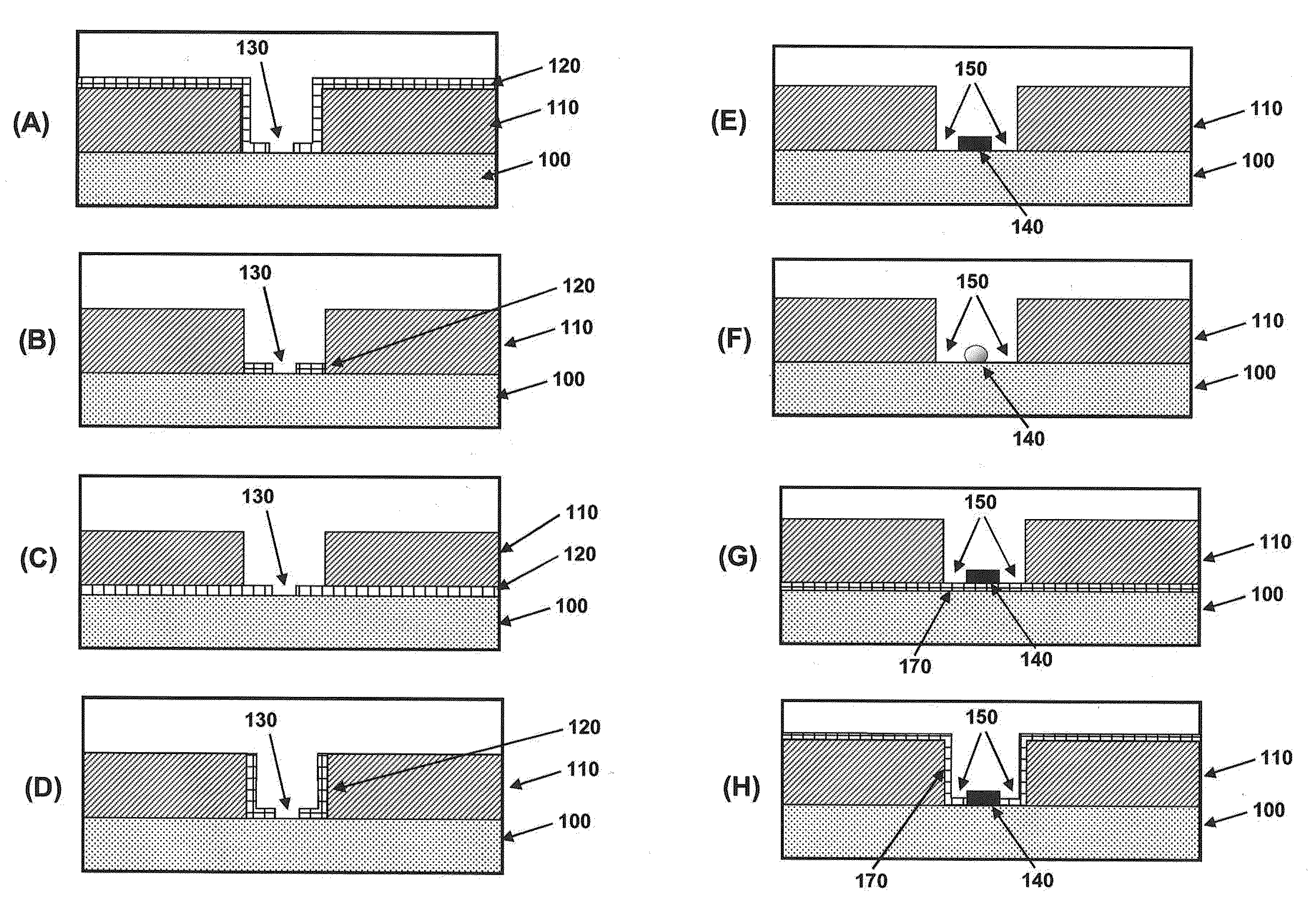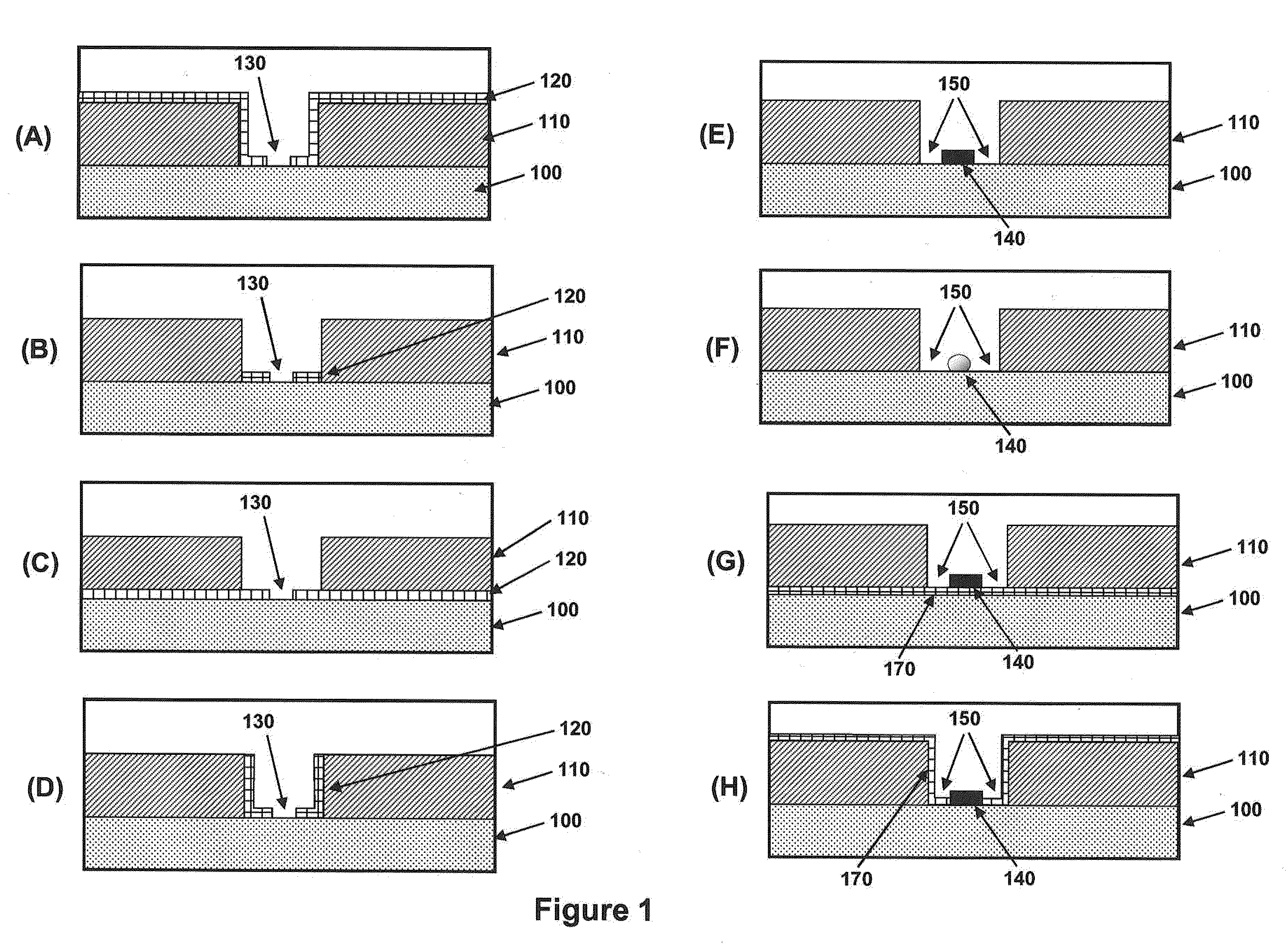Nanoscale apertures having islands of functionality
a functional aperture and nanoscale technology, applied in the field of molecular biology and molecular medicine, can solve the problems of complicating the analysis of signals observed from the double-loaded region, affecting the performance of single molecule analyses, and affecting the stability of the molecule, so as to prevent the binding of additional analyte molecules
- Summary
- Abstract
- Description
- Claims
- Application Information
AI Technical Summary
Benefits of technology
Problems solved by technology
Method used
Image
Examples
example 1
Dimensional Values for Producing Nanoscale Islands of Island Material
[0248]The methods illustrated in FIG. 4 are directed to producing islands of nanodots within nanoscale apertures. FIG. 20A is a drawing illustrating the values of relevant dimensions for the process illustrated in FIG. 4. Table 1 below shows values for the parameters for producing a gold nanodot on the order of 10 nm in diameter. The size of the gold dot can be smaller than the diameter of the sacrificial pillar, due to undercut made during gold wet etching.
TABLE 1W(ZMW)T(sacrificial)t(oxide)σ (undercut)T(gold)W(nano-dot)1100 nm200 nm50 nm35 nm10 nm≦10 nm2120 nm200 nm50 nm45 nm10 nm≦10 nm3140 nm200 nm50 nm55 nm10 nm≦10 nm
example 2
Dimensional Values for Producing Nanoscale Islands of Substrate Surface
[0249]The methods illustrated in FIG. 15 are directed to the formation of islands of substrate surrounded by an isolation layer within a nanoscale aperture. FIG. 20B provides a drawing illustrating the values of the dimensions for the process illustrated in FIG. 15. Table 2 shows values for the parameters for producing an island with a diameter on the order of 10 nm.
TABLE 2W(ZMW)T(sacrificial)t(oxide)σ (undercut)T(alumina)W(island)1100 nm200 nm50 nm45 nm10 nm≦10 nm2120 nm200 nm50 nm55 nm10 nm≦10 nm3140 nm200 nm50 nm65 nm10 nm≦10 nm
example 3
Gold Nano-Dot Islands
[0250]FIG. 21 shows Scanning Electron Micrographs of representative apertures from an array of nanoscale apertures having gold dots disposed within them. The structures were formed using the method illustrated in FIG. 3. FIG. 21A shows a cross-section through a nanoscale aperture. FIG. 21B shows an SEM taken from above the nanoscale aperture showing the gold nanodot at the base of the aperture. Starting from a ZMW having 100 nm thick aluminum on fused silica substrate, 30 nm PECVD amorphous silicon was deposited at 300° C., followed by 7 nm gold / chrome evaporation at room temperature and 9 μTorr. The gold / chrome at the top of ZMW could be removed according to FIG. 3, or by tilted ion milling of gold. Finally, the sacrificial layer was removed in XeF2.
PUM
 Login to View More
Login to View More Abstract
Description
Claims
Application Information
 Login to View More
Login to View More - R&D
- Intellectual Property
- Life Sciences
- Materials
- Tech Scout
- Unparalleled Data Quality
- Higher Quality Content
- 60% Fewer Hallucinations
Browse by: Latest US Patents, China's latest patents, Technical Efficacy Thesaurus, Application Domain, Technology Topic, Popular Technical Reports.
© 2025 PatSnap. All rights reserved.Legal|Privacy policy|Modern Slavery Act Transparency Statement|Sitemap|About US| Contact US: help@patsnap.com



